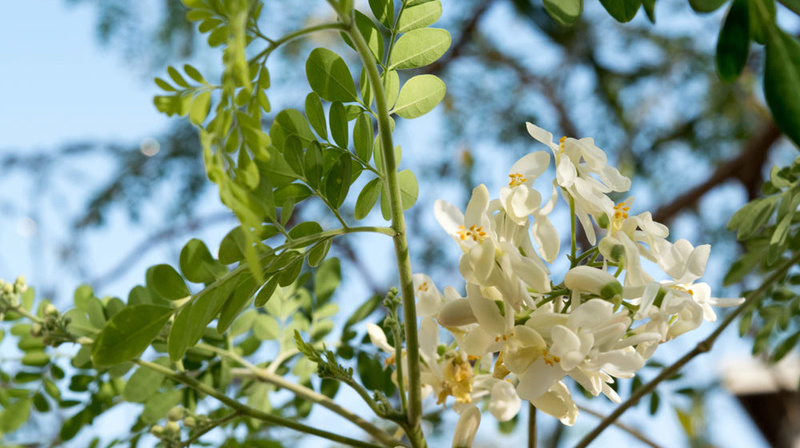
The Superfood Moringa Tree
The moringa tree—also called the ben oil tree, drumstick tree, and horseradish tree—is suited for Florida because it thrives in heat and does well in sandy soil. Its leaves and seed pods are a superfood source of vitamins, proteins, and antioxidants.
Thinking about adding a tree to your landscaping? Consider the moringa–a tree well-suited to Florida because it thrives in heat, withstands drought, does well in sandy soil, and requires little maintenance. It also happens to be a superfood source of vitamins, proteins, and antioxidants.
How it Grows
The moringa tree is a fast-grower and can reach heights of 32-40 feet with a trunk 1.5 feet across. Those who use its leaves and seed pods cut the tree back once a year to 2-6 feet so that the leaves and seed pods are accessible.
The leaves of the moringa tree are small and delicate, giving the foliage a feathery, light look. The seed pods are thin and grow up to a foot long. When the tree blooms, which occurs once a year between April and June, it produces clumps of small, white flowers. (In places with daily rains, the tree can flower more often or even year-round.)
The moringa grows all over the world in semiarid, tropical, and subtropical areas. It is said to be native to the foothills of the Himalayas. It is grown for consumption in India, which produces over a million metric tons of fruit. In Florida, it does well in hardiness zones 9 and 10.
It can be grown from seed or propagated from cuttings. Leaves and stems can be harvested throughout the year.
Planting It
Moringa trees can be grown from branches that are removed from the trunk. The cutting should be at least one inch wide and six feet long. Plant in a hole three feet deep. Pack dirt around it. Water, taking care to keep the water away from the stem.
Moringa trees can also be grown from seeds. Prepare soil by turning it so that it is not compacted. Plant three to five seeds in a furrow approximately one inch deep. Position the seeds two inches apart. Keep the soil moist. When the seeds have sprouted and are 5 inches tall, remove all but the healthiest sapling.
Uses of the Moringa Tree
The moringa tree is also called the ben oil tree (from the oil that is produced from its seeds), the drumstick tree (from the shape of the seed pods), or the horseradish tree (from the taste of its roots).
The whole tree, except for the trunk, is edible. The leaves, pods and seeds contain vitamin C, calcium, potassium, iron, zinc and antioxidants. The leaves can be cooked or eaten fresh.
Moringa tree leaves are the most nutritious part of the tree. Eating them can help lower blood sugar levels, regulate hormonal imbalances, reduce swelling, and boost the immune system.
In places where there is no pure drinking water, the seeds can be used to purify water supplies. In developing countries, the leaves, pods, and seeds are sometimes used to supplement diets, combat malnutrition, and in herbal medicines. They are also planted to help curb soil erosion.
Eating It
Moringa tree leaves and seed pods can be used in salads and added to soups. Grind up moringa tree roots and mix them with dressings or sauces to supply a horseradish kick. Leaves and seed pods can be dried and ground into a powder and added to soups or smoothies.
#floralawn #moringa #superfood #shadetree